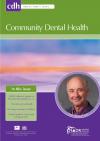Community Dental Health

- Cover Date:
- June 2016
- Print ISSN:
- 0265 539X
- Vol:
- 33
- Issue:
- 2
Fluoride and Oral Health
The discovery during the ï¬rst half of the 20th century of the link between natural fluoride, adjusted fluoride levels in drinking water and reduced dental caries prevalence proved to be a stimulus for worldwide on-going research into the role of fluoride in improving oral health. Epidemiological studies of fluoridation programmes have conï¬rmed their safety and their effectiveness in controlling dental caries. Major advances in our knowledge of how fluoride impacts the caries process have led to the development, assessment of effectiveness and promotion of other fluoride vehicles including salt, milk, tablets, toothpaste, gels and varnishes. In 1993, the World Health Organization convened an Expert Committee to provide authoritative information on the role of fluorides in the promotion of oral health throughout
the world (WHO TRS 846, 1994). This present publication is a revision of the original 1994 document, again using the expertise of researchers from the extensive ï¬elds of knowledge required to successfully implement complex interventions such as the use of fluorides to improve dental and oral health. Financial support for research into the development of these new fluoride strategies has come from many sources including government health departments as well as international and national grant agencies. In addition, the unique role which industry has played in the development, formulation, assessment of effectiveness and promotion of the various fluoride vehicles and
strategies is noteworthy. This updated version of ‘Fluoride and Oral Health’ has adopted an evidence-based approach to its commentary on the different fluoride vehicles and strategies and also to its recommendations. In this regard, full account is taken of the many recent systematic reviews published in peer reviewed literature.
Key words: fluorides, drinking water, salt, milk, supplements, toothpastes, varnishes and gels
doi:10.1922/CDH_3707O’Mullane31
- Article Price
- £15.00
- Institution Article Price
- £
- Page Start
- 69
- Page End
- 99
- Authors
- D.M. O’Mullane, R.J. Baez, S. Jones, M.A. Lennon, P.E. Petersen, A.J. RuggGunn, H. Whelton, G.M. Whitford
Articles from this issue
- Title
- Pg. Start
- Pg. End
- Child oral health in migrant families: A cross-sectional study of caries in 1-4 year old children from migrant backgrounds residing in Melbourne, Australia
- 100
- 106
- Feasibility, utility and impact of a national dental epidemiological survey of three-year-old children in England 2013
- 116
- 120
- A bi-level intervention to improve oral hygiene of older and disabled adults in low-income housing: results of a pilot study
- 127
- 132
- Caries and costs: an evaluation of a school-based fluoride varnish programme for adolescents in a Swedish region
- 138
- 144
- Examiner reliability in fluorosis scoring: a comparison of photographic and clinical methods
- 145
- 150
- Do ‘poor areas’ get the services they deserve? The role of dental services in structural inequalities in oral health
- 164
- 167
